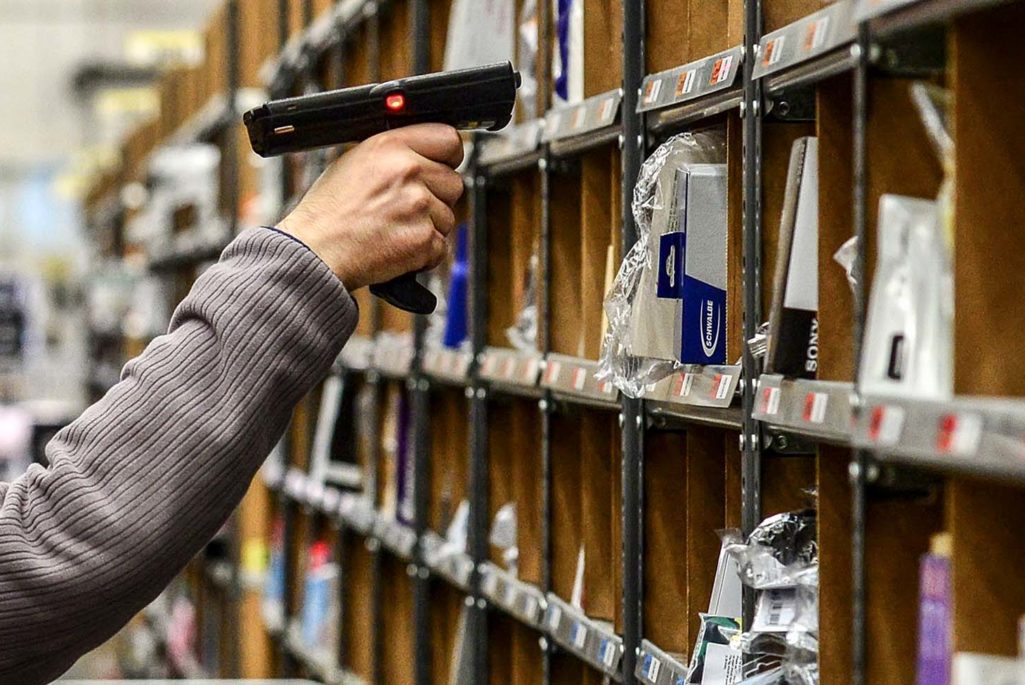Roadmap for Navigating the ‘Frontside Flip’ of Tomorrow’s Digital Supply Chain

An employee scans a barcode on storage shelves at US online retail giant Amazon logistics center in Brieselang, west of Berlin. The digital supply chain will need to utilize big data, analytics and other digital technology gamechangers in the areas of demand, sensing and shaping as well as in production and engineering.
Photo: John MacDougall/AFP/Getty Images
The adoption of and improvements to digital supply chains can reduce procurement costs for all purchases of goods and services by 20 percent, reduce supply chain process costs by 50 percent and increase revenue by 10 percent, according to a new report recently researched and produced by The Center for Global Enterprise (CGE).
The report, Digital Supply Chains: A Frontside Flip, notes that the digital supply chain requires a “frontside flip” that flips the focus to the customer-facing side—the frontside—of the business.
The use of technology has been integral to supply chains for decades. What is new about the digital supply chain and how is it truly disruptive and transformational? A global expert group of senior supply chain executives from more than 25 international companies provided insight for the report into today’s challenges and acted as a sounding board to discuss tomorrow’s opportunities and risks.
One important step was to develop a clear definition for a term that is more widely used, but without a common meaning. A Digital Supply Chain (DSC) is a customer-centric platform model that captures and maximizes utilization of real-time data coming from a variety of sources. It enables demand stimulation, matching, sensing and management to optimize performance and minimize risk.
Consider a new approach by Goodyear. Traditionally, the tire company has sold its products strictly through distributors. Once the tires are in the showroom, Goodyear is out of the loop. Now, the company is working on a new digital supply chain initiative that engages customers directly via the goodyear.com website. The consumer selects their tires, local installer and appointment time and completes the purchase online. Goodyear checks inventory and gets the right tires to the installer by the next day. To gain insights into the expected needs of customers, Goodyear is running projects using real-time search trends, website analytics, big data and point-of-sale information. The channel is also integral to the process, with digital collaborative planning, shared performance measures and real-time reporting.
This example illustrates a number of key gamechangers featured in the report. It exemplifies the core theme of “knowing your customers’ customer” and shows the use of big data and analytics to enable this shift. Goodyear is also centering its strategy on a digital platform—a foundation for a variety of enterprises and individuals to conduct business—which is one of the biggest trends today.
Another gamechanger is the concept of “collaboration with a purpose.” This happens two ways: new internal collaboration, with more horizontal, cross-organizational coordination (e.g., sales, supply chain, information technology [IT]); and external collaboration, as illustrated by Goodyear’s new channel engagements.
The digital supply chain of 2020 will see the evolution of manufacturing and delivery technologies.
Also factoring into the digital supply chain of 2020 is the evolution of manufacturing and delivery technologies: robotics, drones and driverless vehicles and 3D printing. A wild card is blockchain, a new form of database architecture that allows two or more parties, operating through a trusted network, to increase the speed, security and accuracy of settlements on financial and commercial transactions.
Capitalizing on the Digital Supply Chain
Many companies may find it daunting to consider taking steps that will transform business operations. To provide guidance, the report offers a “Digital Supply Chain Execution Roadmap.” It has four elements: managing demand, people, technology and risk.
Managing Demand
Fundamental to successful digital supply chains is the ability to enable real-time, continuous engagement with customers and their customers to stimulate and manage demand. The data and insight gained from the sales side must be shared with suppliers to efficiently match supply and demand. To do this, the report suggests four activities that a CEO must do:
- Ensure that the organization is capturing the necessary real-time actionable data collected from a wide range of sources ranging from social media, sensors and internet of things (IoT) connected devices to supplier and customer data.
- Analyze data and utilize it to determine customer demand.
- Provide a clear mandate for managing demand (and matching it to supply) and stimulating new market demand.
- Develop a new, demand-focused scorecard for the digital supply chain.
Managing People
CEOs need to recognize that the “frontside flip” approach requires a new team with an expanded skillset beyond those managing traditional supply chain teams.
To start, CEOs should appoint a senior leader with the experience and knowledge needed to move ahead with the new technologies critical to the digital supply chain and understand how to facilitate “collaboration with a purpose.” The supply chain team will need to know how to utilize big data, analytics and other digital technology gamechangers in the areas of demand, sensing and shaping as well as in production and engineering. They will need to understand the key decisions that need to be made, with a focus on when and where to make them and what data is needed.
These new supply chain leaders and their teams should also be empowered with technology, budget and decision-making authority to drive that change through new people, new skills and new individual and group performance metrics. People and teams within this new digital supply chain must also be capable and effective working cross-functionally with their internal counterparts and those in supplier and customer organizations, such as sales, manufacturing, IT and research and development (R&D).
Managing Technology
The shift to a digital supply chain also requires investments in technology that span the entire company and enables real-time visibility. One clear message that emerged from the global experts group is that there are already huge amounts of data available; the challenge is using it. Actions could include:
- Enhance visibility and response to customers with initiatives such as linking internal data silos, analyzing external data and implementing a data management system with an overall purpose to better integrate, capture, clean and use data.
- Invest in digital supply chain platform technology that enables greater business and corporate agility for collaboration.
- Consider integrating new technologies to enhance manufacturing and delivery.
- Develop new metrics to measure technology return-on-investment for the digital supply chain.
Managing Risk
The advance of the digital supply chain will enable companies to scale supply chain risk-management programs. Supply chain visibility will be easier through new data and technology. but technology should not drive the strategic risk decisions—the decisions should shape the technology. The focus should be to shift from reactive to proactive, using data to better predict risks and incidents.
The new digital supply chain involves greater collaboration across companies and with third parties. As such, companies need to consider ways to assess third party controls and work to improve vulnerabilities, particularly in the areas of information security and cyber protection.
Senior management will need to use the available data to shift from dealing with negative events reactively in separate silos to taking a more preventative approach. This is true for both business performance and compliance risks. By taking a holistic approach using management systems and business processes, companies can deal with a wide range of different risks in an organized and integrated way.
For decades, companies have optimized supply chains by streamlining manufacturing and logistics. Moving forward, companies have the opportunity to get closer to the needs of customers and collaborate with suppliers in a new way by embracing the digital supply chain




